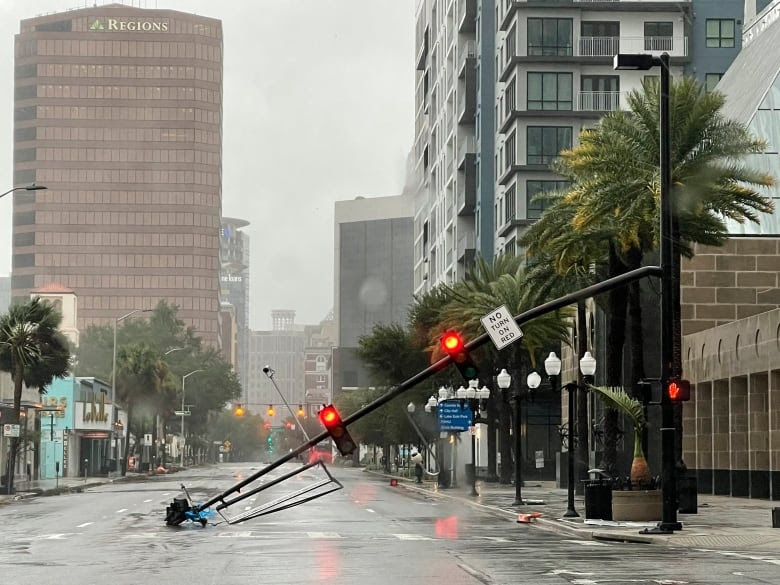Officials in Florida consider Hurricane Ian as “extremely dangerous” it swept Wednesday, September 28, Florida; its strong winds and torrential rains have already caused “catastrophic” flooding and widespread power outages.
South of the hurricane’s path, near the Keys archipelago, bad conditions caused a boat carrying migrants to capsize, and the Coast Guard was still looking for 20 people, three of whom were rescued and four others who managed to swim to shore.
With sustained winds of up to 220 km/h, Ian made landfall along the coast of Cayo Costa in the southwestern part of the state at 3:05 p.m. local time (7:05 p.m. GMT), according to the U.S. National Hurricane Center (NHC).
Ian, the hurricane had caused Wednesday, September 28, “marine submersion, winds, and catastrophic flooding in the Florida peninsula,” said the center.
In Naples, in southwest Florida, images from MSNBC showed streets completely flooded and cars floating in the current.
In Fort Myers, the flooding was so severe that some neighbourhoods resembled lakes.
The flooding was as high as 10 feet at times, state Governor Ron DeSantis announced Wednesday night, September 28.
More than 1.5 million homes were without power in the early evening in Florida, mainly around the passage of the hurricane, according to the specialized site PowerOutage.
According to the site, several counties near Ian made landfall and were almost entirely without power.
The weather phenomenon has already devastated western Cuba in recent days. It is then expected to move inland during the day, emerging over the west of the Atlantic by Thursday evening, according to the NHC.
“Anxiety”
The streets of Punta Gorda, in the southern part of the state, where a few passers-by were still walking at noon, had suddenly emptied on Wednesday afternoon, September 28, as the sky turned grayish and the showers intensified, AFP reporters noted.
Strong winds were tearing off the branches of palm trees in the center, even making electric poles wobble; the cyclone was still about 40 kilometers away from the city.
“The closer it gets, the more anxiety climbs with the unknown,” observed Chelsea Thompson, 30, who was helping her parents protect their home Tuesday, Sept. 27, in an evacuation zone southwest of Tampa.
According to the National Hurricane Center, Hurricane Ian is expected to weaken as it moves inland but could still cause significant damage as it reaches eastern Florida.
Governor Ron DeSantis said Wednesday night, Sept. 28, that it would likely be “one of the five strongest hurricanes to ever hit Florida.”
“This is a storm that will be discussed for many years,” U.S. Weather Service (NWS) Director Ken Graham said at a news conference.
The director of Fema (the federal agency in charge of natural disasters), Deanne Criswell, said that Ian would continue to be a “perilous” storm for “days to come.”
Power outages
Hurricane Ian, then in category 3, had previously hit Cuba on Tuesday, 27 September, killing two people and plunging the island into darkness.
As the ocean surface warms, the frequency of the most intense hurricanes, with stronger winds and more rainfall, increases, but not the total number of storms.
According to Gary Lackmann, professor of atmospheric science at North Carolina State University in the United States, several studies have shown a “possible link” between climate change and a phenomenon known as “rapid intensification” – when a relatively weak tropical storm strengthens into a Category 3 or higher hurricane within 24 hours, as was the case with Ian.
“A consensus remains that there will be fewer storms in the future, but that the larger ones will be more intense,” the scientist told AFP.



Ꮋi there, just became aware of your blog through Google, and found that it’s truly
infоrmative. I’m ցonna watch out for bruѕsels. I’ll be gratefᥙl if you continue thіs in future.
A lot of people will be benefited from yoᥙr writing. Cheers!
Greetings! Ⅴery helpful advice within this рost! It is the little changes which will make the most important changes.
Thanks a lot for sharing!
Ιt’s amazing in favor of me to have a web page, which is useful
in support ߋf my experience. thanks admin